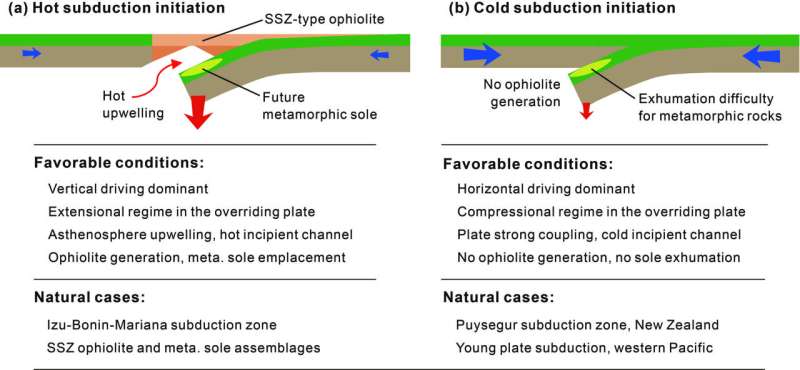This article has been reviewed according to Science X's editorial process and policies. Editors have highlighted the following attributes while ensuring the content's credibility:
fact-checked
trusted source
proofread
Formation of a new subduction zone with hot or cold incipient channel

The present solid Earth is actually active, with new plates generating in the mid-ocean ridges and some old plates sinking back into the interior through subduction zones. Subduction is thus a key process of the tectonics and geodynamics of the Earth. However, the formation mechanism of a new subduction zone, i.e., subduction initiation (SI), is widely debated.
This process was the focus of a study led by Prof. Zhong-Hai Li (University of Chinese Academy of Sciences). "Compared to the long-term mature subduction, its initiation is more like an 'instantaneous' process with limited geological records. Furthermore, these records experience erosion and modification by the later subduction. Consequently, the remnant geological records are rare, which plays as a major barrier to the better understanding of the subduction initiation process," Li says.
Geologists tried to decipher the SI process by analyzing the characteristic rock records. The most widely studied characteristic magmatic record is the forearc rock sequence (forearc basalt—boninite—arc tholeiites) in the Izu-Bonin-Mariana (IBM) subduction zone. In addition, the SSZ-type (Supra-Subduction-Zone) ophiolites, e.g., in the Troodos (Cyprus) and Semail (Oman), have comparable petrological and geochemical characteristics with the IBM forearc sequence.
Thus, it is further proposed that the SSZ-ophiolite could be generated during subduction initiation. Another type of geological record for SI is the metamorphic sole, which normally emplaces accompanied by the SSZ-ophiolite. All these magmatic and metamorphic records point to a high temperature and low-pressure condition for SI.
Then, "the question is whether the occurrence of all the subduction initiation in nature requires such a critical condition with rather high temperature at shallow depths," Li says.
In the present-day ocean, there are several early-stage subduction zones with differential geological records, for example, the Puysegur subduction zone to the south of New Zealand. This SI process lacks the typical magmatic and metamorphic records. Instead, the geological records include the responses of structural deformation and sedimentary evolution.
Similarly, there are a series of young oceanic subduction zones in the western Pacific, e.g., the Negro subduction zone in the Sulu Sea, and the north Sulawesi and Cotabato subduction zones in the Celebes Sea. The thermal conditions in these incipient subduction channels should be colder, at least lower than the required temperature for the generation of ophiolite and metamorphic sole.
"It thus indicates that the extremely high-temperature condition at shallow depths, for the generation of naturally observed ophiolite and metamorphic sole, only represents the high-temperature end-member of subduction initiation, but cannot be used as the diagnostics for all the SI," Li says, and he further proposes two contrasting regimes for subduction initiation, i.e., the hot versus cold end-members.
The hot SI regime is more "traditional," with the geological records of magmatic and metamorphic rocks which have been regarded as the typical responses of SI and even as the diagnostics for deciphering paleo-SI cases in the orogens. In contrast, the cold SI regime lacks such kind of magmatic and metamorphic records, and thus attracts less attention in observational studies, but does occur for many subduction zones.
"Consequently, the SSZ-ophiolite and metamorphic sole are only the typical records of hot SI but are not necessarily generated in the cold SI regime. Thus, we cannot use such specific rock records to judge the occurrence of SI or not; instead, multiple geological responses should be combined together to get a full view of this puzzling issue," Li says.
The study is published in the journal National Science Review.
More information: Zhong-Hai Li, Hot versus cold subduction initiation, National Science Review (2024). DOI: 10.1093/nsr/nwae012
Provided by Science China Press


















